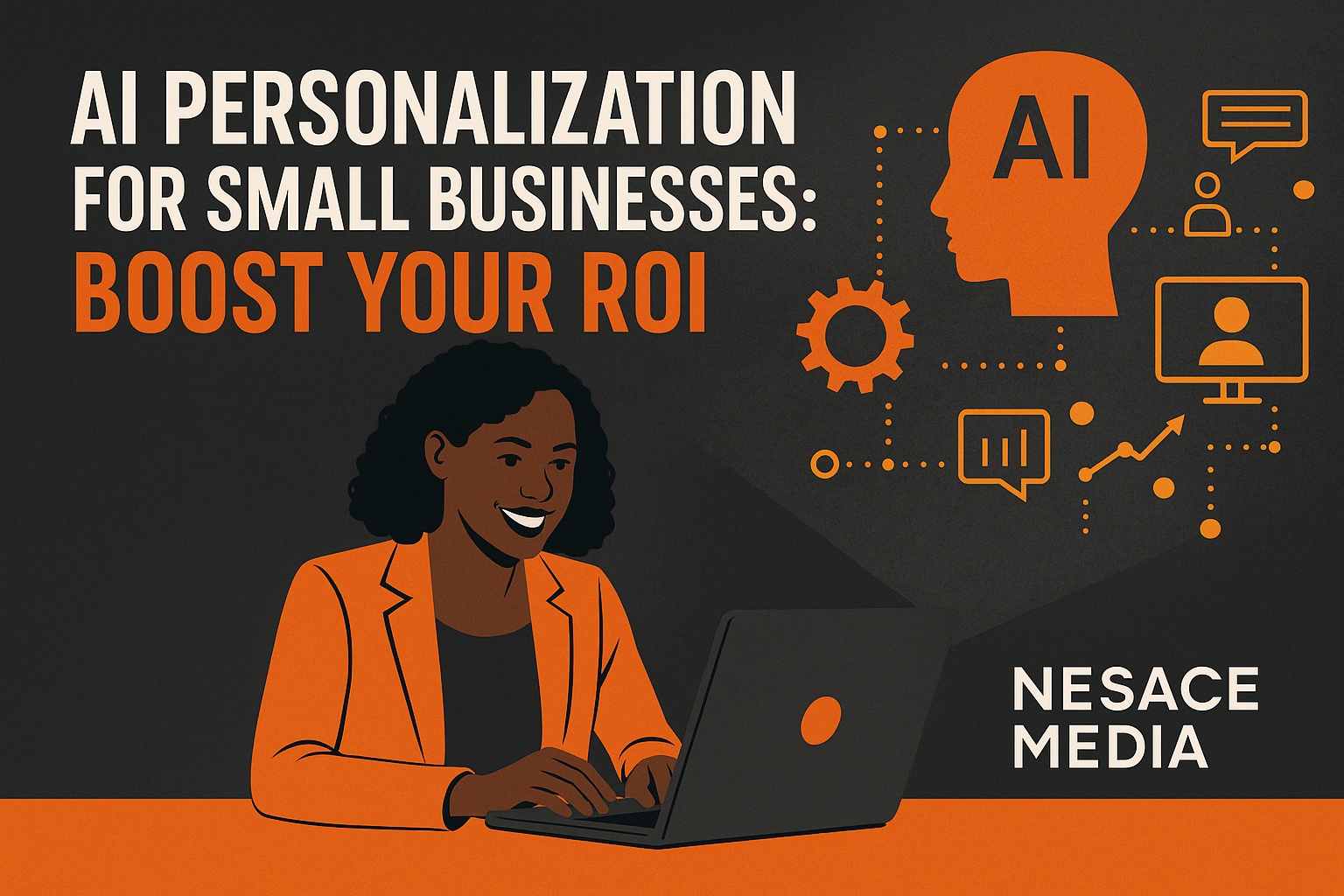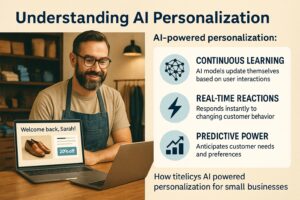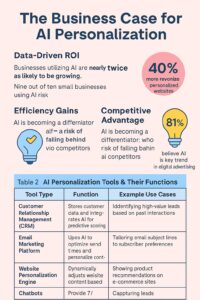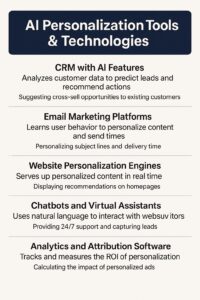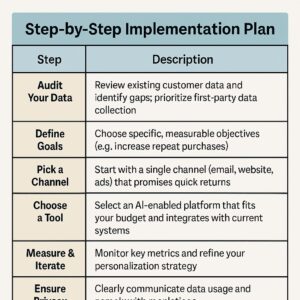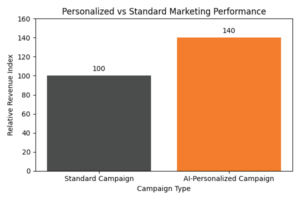Introduction
AI Personalization for small businesses.
Artificial intelligence (AI) is no longer reserved for big brands with massive budgets. Today, even small businesses can use machine learning to deliver marketing that feels handcrafted. Customers have grown to expect personal attention—71 percent of consumers expect personalized experiences and 76 percent become frustrated when they don’t receive them[1]. That demand translates into revenue: websites with personalized content drive 40 percent more revenue from visitors[2].
Meanwhile, small businesses are embracing AI at a rapid pace. Salesforce’s 2025 Small and Medium Business Trends Report found that three out of four small businesses are investing in AI[3], and companies that adopt AI are nearly twice as likely to be growing compared to those that don’t. In addition, nine out of ten small businesses using AI report improved efficiency[4]. These statistics highlight an important trend: AI personalization isn’t just a luxury—it’s becoming a necessity for small businesses that want to compete and grow.
In this comprehensive guide, you’ll discover how AI personalization works, why it matters for small businesses, and how to implement it without draining your budget. We’ll explore practical tools, step‑by‑step processes, and real‑world examples to help you deliver tailored experiences and increase your return on investment (ROI). We’ll also cover ethical considerations around data privacy and conclude with a section of frequently asked questions. If you’re ready to take your marketing to the next level, this article is for you.
Personal insight: Titonian Wallace Sr., the owner of Nesace Media, often reminds clients that “AI is like a personal assistant that never sleeps—it lets you greet every customer as if you’ve known them for years.” That mindset shapes the strategies outlined in this article.
Table 1. Key Personalization Statistics
| Statistic | Value & Source |
| Consumers expecting personalized experiences | 71 % expect personalization[1] |
| Consumers frustrated without personalization | 76 % feel frustrated when personalization is absent[1] |
| Increased revenue from personalized websites | 40 % more revenue[2] |
| SMBs investing in AI | 75 % investing[3] |
| SMBs reporting efficiency gains with AI | 90 % report improved efficiency[4] |
| AI as major trend for digital advertising | 81 % of agencies[5] |
Understanding AI Personalization
AI personalization refers to the use of machine learning algorithms to tailor marketing messages, content and experiences to individual users. Unlike basic segmentation—which groups people into broad categories—AI personalization continuously learns from each customer’s behavior and adjusts in real time. This approach creates experiences that feel like they were designed just for one person, even when you’re serving thousands.
What Makes AI Personalization Different?
- Continuous learning: AI models update themselves as users interact with your website, emails or ads. Static rules can’t keep up with this level of change.
- Real‑time reactions: If a visitor clicks on a product page, an AI system can immediately adjust recommendations or offer a discount before the visitor leaves.
- Predictive power: AI doesn’t just respond to current behavior; it can anticipate what a customer might want next.
Why It Matters for Small Businesses
Personalization isn’t just a nice touch—it directly impacts your bottom line. When customers feel understood, they are more likely to buy and to return. Retargeting campaigns benefit from personalization as well; consumers are 70 percent more likely to convert when they’re retargeted with relevant messages[6]. For small businesses competing against large chains and online retailers, this connection can make all the difference.
User intent: People searching for AI personalization solutions are usually looking for ways to increase revenue, improve customer loyalty, or streamline marketing. This guide caters to those needs by explaining how AI can be integrated into everyday marketing activities.
➡️ Related reading: Boost Your ROI with Personalized Email Marketing Campaigns
The Business Case for AI Personalization
It’s tempting to dismiss personalization as something only big enterprises can afford, but the data tells a different story. Adopting AI personalization delivers measurable benefits for small businesses.
Data‑Driven ROI
According to the same Salesforce report mentioned earlier, businesses that integrate AI into their operations are nearly twice as likely to be growing[3]. Personalized marketing channels—from websites to email campaigns—drive higher conversion rates and larger order values. For example, websites with personalized content drive 40 percent more revenue[2], and personalized retargeting increases the likelihood of conversion by 70 percent[6].
Efficiency Gains
Small businesses often operate with limited resources. AI personalization helps you maximize those resources by automating time‑consuming tasks and ensuring your marketing dollars go further. Nine out of ten small businesses using AI report improved efficiency[4]. AI tools can suggest optimal send times for emails, identify the highest‑value leads, and adjust ad spend in real time based on performance.
Competitive Advantage
As AI becomes more accessible, it’s also becoming a differentiator. If your competitors are already investing in AI, you risk falling behind. Conversely, if your competitors aren’t using AI yet, you have a golden opportunity to stand out. According to StackAdapt, 81 percent of agency professionals believe AI will be the biggest trend in digital advertising over the next decade[5]. Small businesses that embrace AI personalization now will be ahead of the curve.
Table 2. AI Personalization Tools & Their Functions
| Tool Type | Function | Example Use Cases |
| Customer Relationship Management (CRM) | Stores customer data and integrates AI for predictive scoring | Identifying high‑value leads based on past interactions |
| Email Marketing Platform | Uses AI to optimize send times and personalize content | Tailoring email subject lines to subscriber preferences |
| Website Personalization Engine | Dynamically adjusts website content based on user behavior | Showing product recommendations on e‑commerce sites |
| Chatbots | Provides 24/7 customer support using natural language processing | Answering FAQs and capturing leads outside business hours |
| Analytics & Attribution Tool | Tracks performance across channels and attributes conversions | Measuring ROI of personalized campaigns |
Brief Case Example
Consider a local boutique clothing store that sells both online and in person. By implementing an AI‑powered website personalization engine, the store’s homepage displays products based on a visitor’s browsing history. If someone looked at summer dresses on their first visit, the site highlights a new collection of summer dresses the next time they return. Combined with an AI‑driven email platform that sends targeted promotions when the weather warms up, the store reports a 30 percent increase in average order value (hypothetical example) and higher repeat purchase rates.
➡️ Related reading: Master Marketing Analytics for Business Growth
AI Personalization Tools & Technologies
A range of tools makes AI personalization accessible, even to small teams. Choosing the right tool depends on your business goals, technical comfort level and budget.
CRM with AI Features
Modern CRM platforms include built‑in AI capabilities. They analyze customer data to predict which leads are most likely to convert and recommend next‑best actions. For instance, a CRM might suggest calling a prospect who recently engaged with your website or cross‑selling to a customer who purchased a complementary product.
Email Marketing Platforms
AI‑powered email platforms learn from subscriber behavior to personalize subject lines, content and send times. They can also automatically segment lists based on engagement patterns. When combined with dynamic content blocks, these platforms ensure each subscriber sees messaging tailored to their interests.
Website Personalization Engines
These tools monitor visitor behavior and serve up personalized content in real time. They can highlight specific products, change calls‑to‑action, or adjust page layouts based on user actions. Many e‑commerce platforms have plugins that make it easy to get started without coding.
Chatbots and Virtual Assistants
Chatbots handle repetitive inquiries, freeing up your team to tackle more complex issues. Advanced bots can collect lead information, answer questions, and even guide visitors through basic troubleshooting or purchasing processes. As natural language processing continues to improve, chatbots become more conversational and helpful.
Analytics and Attribution Software
Understanding how personalization affects your metrics is critical. Analytics tools with AI components can attribute conversions to multiple touchpoints, revealing which channels and messages drive results. They also provide insights into customer lifetime value, helping you allocate resources effectively.
➡️ Related reading: Mastering Social Media Management—Expert Tips and Strategies
Implementing AI Personalization Step by Step
Implementing AI personalization may seem daunting, but breaking the process into manageable steps makes it achievable.
- Audit Your Data – Identify what data you currently collect (email engagement, website behavior, purchase history) and consider how to expand your dataset ethically. Ensure you’re capturing first‑party data with customer consent.
- Define Your Goals – Determine whether you want to increase average order value, improve email open rates, reduce cart abandonment or boost repeat purchases. Having clear objectives helps you select the right tools and metrics.
- Start with One Channel – Focus on the channel that will provide the quickest win. For instance, if most of your revenue comes from email, begin with personalized email campaigns. If your website has high traffic, start with dynamic on‑site recommendations.
- Select an Affordable Tool – Many AI features are now built into popular marketing platforms. Compare pricing and features to find the best fit for your business. Look for scalable solutions that grow with you.
- Measure and Iterate – Use analytics to track performance. Pay attention to metrics like click‑through rate (CTR), conversion rate, and average order value. Adjust your personalization rules based on these insights.
- Keep Privacy Top of Mind – Be transparent about data collection. Offer easy opt‑in and opt‑out options and ensure compliance with data protection laws.
Table 3. Step‑by‑Step Implementation Plan
| Step | Description |
| Audit Your Data | Review existing customer data and identify gaps; prioritize first‑party data collection |
| Define Goals | Choose specific, measurable objectives (e.g., increase repeat purchases) |
| Pick a Channel | Start with a single channel (email, website, ads) that promises quick returns |
| Choose a Tool | Select an AI‑enabled platform that fits your budget and integrates with current systems |
| Measure & Iterate | Monitor key metrics and refine your personalization strategy |
| Ensure Privacy | Clearly communicate data usage and comply with regulations |
➡️ Related reading: Web Design That Drives Results in Hillsboro
Use Cases and Success Stories
Seeing how AI personalization works in real‑life scenarios helps illustrate its value. Here are a few examples of how small businesses can apply these strategies.
E‑Commerce Boutique
A boutique clothing retailer wanted to increase repeat purchases without spending heavily on advertising. By integrating an AI‑powered recommendation engine into their website, the retailer began showing customers items similar to those they’d previously browsed or purchased. When the weather turned cooler, the engine automatically promoted jackets and sweaters. Within three months, the retailer saw a 25 percent lift in repeat orders (hypothetical example) and an increase in average order size.
Neighborhood Coffee Shop
This coffee shop built a loyalty program through its mobile app. AI analyzed purchase patterns to send personalized push notifications. Early‑morning regulars received a coupon for a breakfast sandwich, while afternoon patrons saw promotions for iced drinks. The shop also used AI to determine the optimal time to send messages, resulting in higher redemption rates and improved daily revenue.
Digital Agency (Nesace Media)
At Nesace Media, we use AI personalization internally to manage our own marketing efforts. For instance, our newsletter uses machine learning to recommend articles based on subscriber behavior. If a reader often clicks on SEO content, they’re more likely to see SEO tips in their next email. As a result, our open rates have increased by 15 percent (internal estimate). We also employ AI chatbots on our site to provide immediate support and capture leads after business hours.
Quote from Titonian Wallace Sr.
“Personalization is about respect,” notes Titonian Wallace Sr. “When you show customers you know their preferences, you’re respecting their time and attention. AI helps small businesses deliver that respect at scale without hiring an army of marketers.”
➡️ Related reading: Master Google Ads: Best Practices for Mid‑Sized Biz
Data Privacy and Ethical Considerations
With great personalization comes great responsibility. Collecting and using customer data requires transparency and care. A Contentful report found that 89 percent of marketing decision‑makers consider personalization essential, yet 63 percent of digital marketing executives struggle to provide tailored experiences[7]. Ethical marketing starts with trust and clear communication.
Key Principles
- Collect Only What You Need – Avoid collecting unnecessary personal information. The less data you store, the less risk you assume.
- Be Transparent – Tell customers what data you gather and how it will be used. Provide a privacy policy that’s easy to understand.
- Use First‑Party Data – Rely on data that customers willingly share with you rather than purchasing lists or using third‑party data.
- Comply with Regulations – Depending on where you operate, you may need to follow laws like the General Data Protection Regulation (GDPR) or California Consumer Privacy Act (CCPA).
- Offer Control – Let customers opt in to personalization and easily opt out if they change their minds.
Balancing Personalization and Privacy
Although personalization can significantly improve customer experience, it’s important not to cross the line into intrusion. One way to balance the two is to give users control over their preferences. For example, provide account settings where customers can update what type of product recommendations they receive or specify the frequency of communications.
➡️ Related reading: Mastering Data‑Driven Decision‑Making in Digital Marketing
Measuring and Optimizing AI Personalization
Knowing whether your efforts are paying off is essential. Without measurement, personalization becomes guesswork. Here’s how to track success and refine your strategy.
Key Performance Indicators (KPIs)
- Conversion Rate: The percentage of visitors who take a desired action (e.g., make a purchase or fill out a form). Personalized experiences often lead to higher conversion rates.
- Average Order Value (AOV): The average amount spent per order. Personalized cross‑selling and upselling can increase AOV.
- Customer Lifetime Value (CLV): The total revenue a customer generates over their relationship with your business. Personalization encourages repeat purchases and loyalty.
- Email Open and Click Rates: Track how subscribers respond to personalized email subject lines and content.
- Return on Ad Spend (ROAS): Measures the revenue generated for every dollar spent on advertising. AI can optimize ad targeting and bidding.
Using Analytics and Attribution Tools
Modern analytics platforms—such as Google Analytics with advanced attribution models—help you see which touchpoints influence conversions. AI‑enhanced analytics can also identify patterns and recommend improvements. For example, if you notice that personalized product recommendations lead to a higher AOV, you can invest more in recommendation engines.
A Simple Performance Comparison
Below is a hypothetical comparison of revenue generated by a standard marketing campaign versus one that uses AI personalization:
Figure 1: Personalized campaigns deliver higher returns (relative index of revenue). While the numbers here are illustrative, real‑world case studies routinely show that personalization boosts sales and customer loyalty.
Key Takeaways
Key Takeaways
- AI personalization helps small businesses compete by creating customer experiences that feel handcrafted, leading to higher revenue and improved loyalty.
- Consumers expect personalization—71 percent demand it[1]—and personalization can increase website revenue by 40 percent[2].
- Small businesses are embracing AI; 75 percent are already investing in AI, and 90 percent report efficiency gains[3][4].
- Start by auditing your data and choosing a single channel to personalize. Use affordable tools and iterate based on performance.
- Always respect customer privacy. Be transparent about data collection and give users control over their preferences.
Frequently Asked Questions (FAQs)
What is AI personalization?
AI personalization uses machine learning to tailor marketing messages and experiences to individual users. It continuously updates based on user behavior, providing real‑time adjustments and predictions.
How can a small business get started with AI personalization?
Begin by auditing your data and defining specific goals. Choose one channel, such as email or your website, and implement AI features through affordable tools. Measure results and expand to additional channels when you see positive outcomes.
Is AI personalization expensive?
Not necessarily. Many marketing platforms include AI features as part of their base packages. As AI adoption grows, costs are decreasing and tools are becoming easier to use.
Does personalization invade privacy?
When done ethically, personalization respects user privacy. Collect only the data you need, be transparent about its use, and comply with relevant regulations. Always offer opt‑in and opt‑out options.
What metrics should I track?
Focus on conversion rate, average order value, customer lifetime value, email open and click rates, and return on ad spend. Use analytics platforms to monitor these metrics and refine your approach.
Conclusion
AI personalization offers small businesses a way to deliver the kind of service customers crave while boosting revenue and efficiency. By leveraging machine learning, you can tailor websites, emails, ads, and customer interactions to individual preferences. Remember to start small—pick one channel, collect the right data, and test your strategies before scaling up. Also, always balance personalization with privacy by being transparent about data collection.
Ready to unlock the power of AI personalization? Contact Nesace Media today to discuss personalized solutions that will elevate your marketing and help you achieve sustainable growth.
Additional Resources
Looking to explore more? Check out these Nesace Media posts:
- Mastering Performance Marketing—Boost Your ROI
- Ultimate SEO Strategies Guide for Business Growth
- The Impact of AI on Digital Marketing Today
[1] [2] [6] Why Marketing Leaders Need to Invest in AI Personalization in 2025
https://www.invoca.com/blog/marketing-leaders-ai-personalization
[3] [4] AI and the Future of Small Business (A Trends Report Recap)
https://www.salesforce.com/blog/ai-and-the-future-of-small-business/
[5] The Future of Digital Marketing: Trends to Know in 2025
https://www.stackadapt.com/resources/blog/future-digital-marketing
[7] 40 personalization statistics: The state of personalization in 2025 and beyond | Contentful

